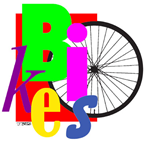Riding on Air
Rick Proctor
Tires don’t help you look better, fix your plumbing problems, or resolve political issues, but you gotta have them. Pneumatic tires provide the bike rider with the cushion of air for the wonderful feeling we like as we fly over the ground. Tires must be tough and durable to provide their function reliably, yet tires are also vulnerable to unfavorable environmental conditions that can end the joy ride when a puncture happens and the compressed air in the tire escapes. Here in America, we commonly refer to this situation as a flat.
There are lots of good quality bike tires on the global market that will last for many thousands of miles, and with some good maintenance and a measure of luck, there can be very few flats. Some bike tires resist flats better than others, but if you want to know what you can do to help prevent flats with the tires you have now – read on:
- 1. Avoid riding over the stuff that causes flats. Easy to say, but not so easy to do.
- 2. Inspect your tires. Every time I lube a bike chain, which happens at around 100 mile intervals, I check the tires for embedded debris like glass, thorns, sharp rocks, staples, nails, screws, etc. that could cause a flat. I also do this as soon as possible after riding through suspicious debris. Note: this is much easier when the tires are clean. With good lighting and wearing safety glasses I’ll look and feel with a finger for embedded debris in the tire centerline that contacts the ground all the way around the tire. Carefully remove any debris that can be seen or felt using a non-sharp instrument, like a small flat blade screwdriver. The idea here is to push down the rubber around the debris and coax the alien item out without punching a hole into the tire/tube. Wear safety glasses. I’ve had stuff pop out of the tire and ping off my glasses – the kind of stuff that could have caused an eye injury or a flat tire. The rubber around a piece of debris can squeeze it enough to eject it when sufficiently loosened. Occasionally small needle-nose pliers may be needed to remove bits of wire embedded in a tire. Also look for tire irregularities and excessive wear and replace the tire when necessary. This inspection process usually takes only a few minutes at home but could prevent an inconvenient roadside flat.
- 3. Check tire pressures, pump as required, then check the pressure again. When I check the pressure before pumping, I look for reasonable pressure remaining since the last time I checked it. If it’s flat, or going flat, fix it. I check the pressure after pumping to be sure removing the chuck from the stem did not release too much air pressure.
- 4. When you get the pressure where you want it, be sure to carefully close the presta valve on the stem, then put the cap on the stem to keep the valve clean for the next time. Even a little bit of dirt on the valve stem can be blown into the valve when checking and adjusting pressure, causing it to leak when you think it is closed. I’ve found several leaking valve stems over the years, which requires removing the tire to replace the tube and stem assembly.
- 5. Valve stems can leak with tubeless setups too, so it’s a good idea to keep a spare stem or a spare tube (which includes a stem) on your bike for roadside repairs.
The pneumatic tire for bikes was invented by a Scotsman, John Boyd Dunlop in 1888. Yep, this was before pneumatic tires for cars! While pneumatic tires were one of the most significant improvements for bikes, flat tires were introduced as a day-denting experience. Most of us who ride bikes don’t like to fix flats, especially while out on a ride, and the visual profile provided to onlookers of a cyclist fixing a flat – well . . . it doesn’t look like fun. Take care of your tires and they will be there for you when you need them. Have a great ride!


